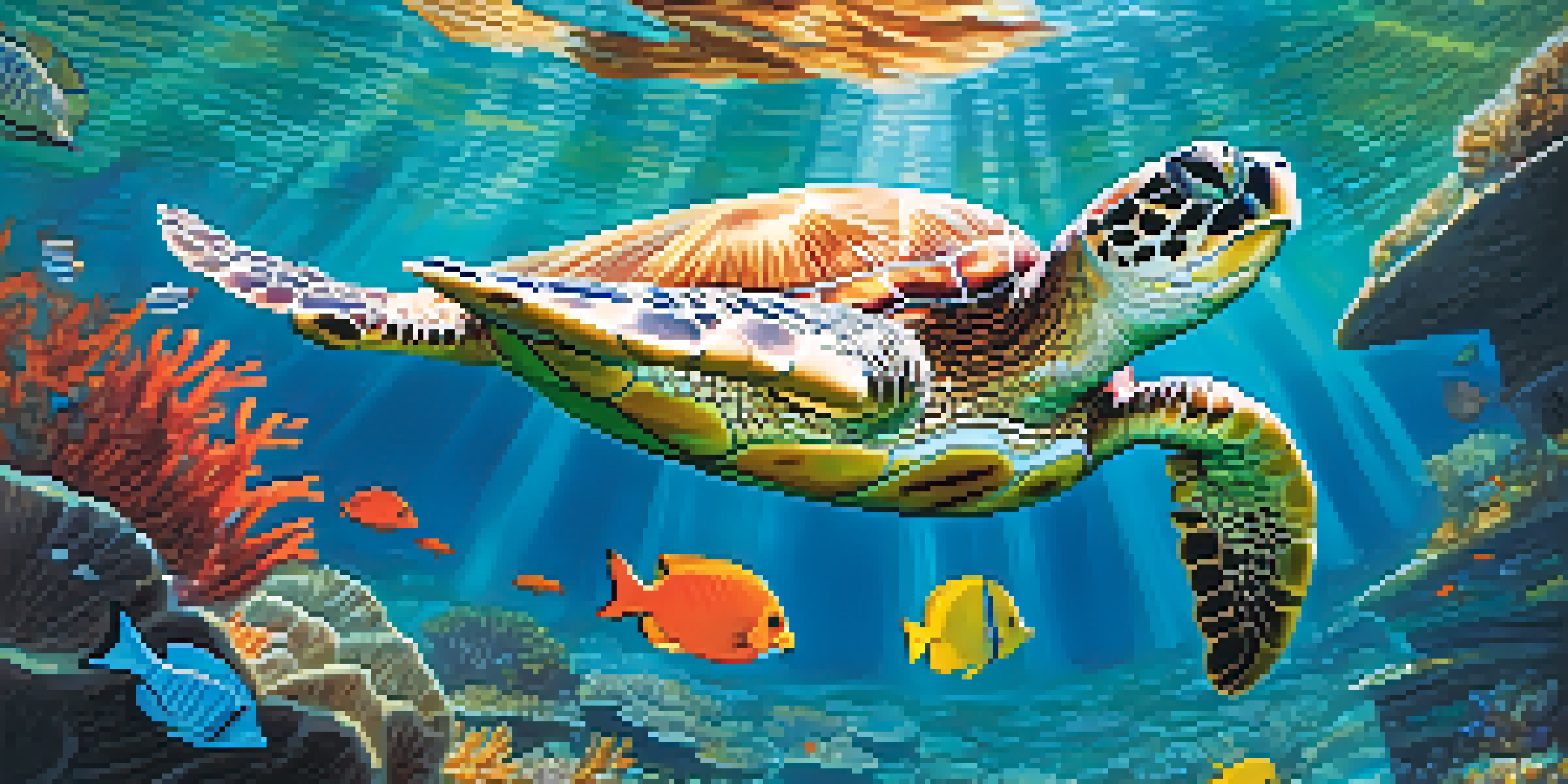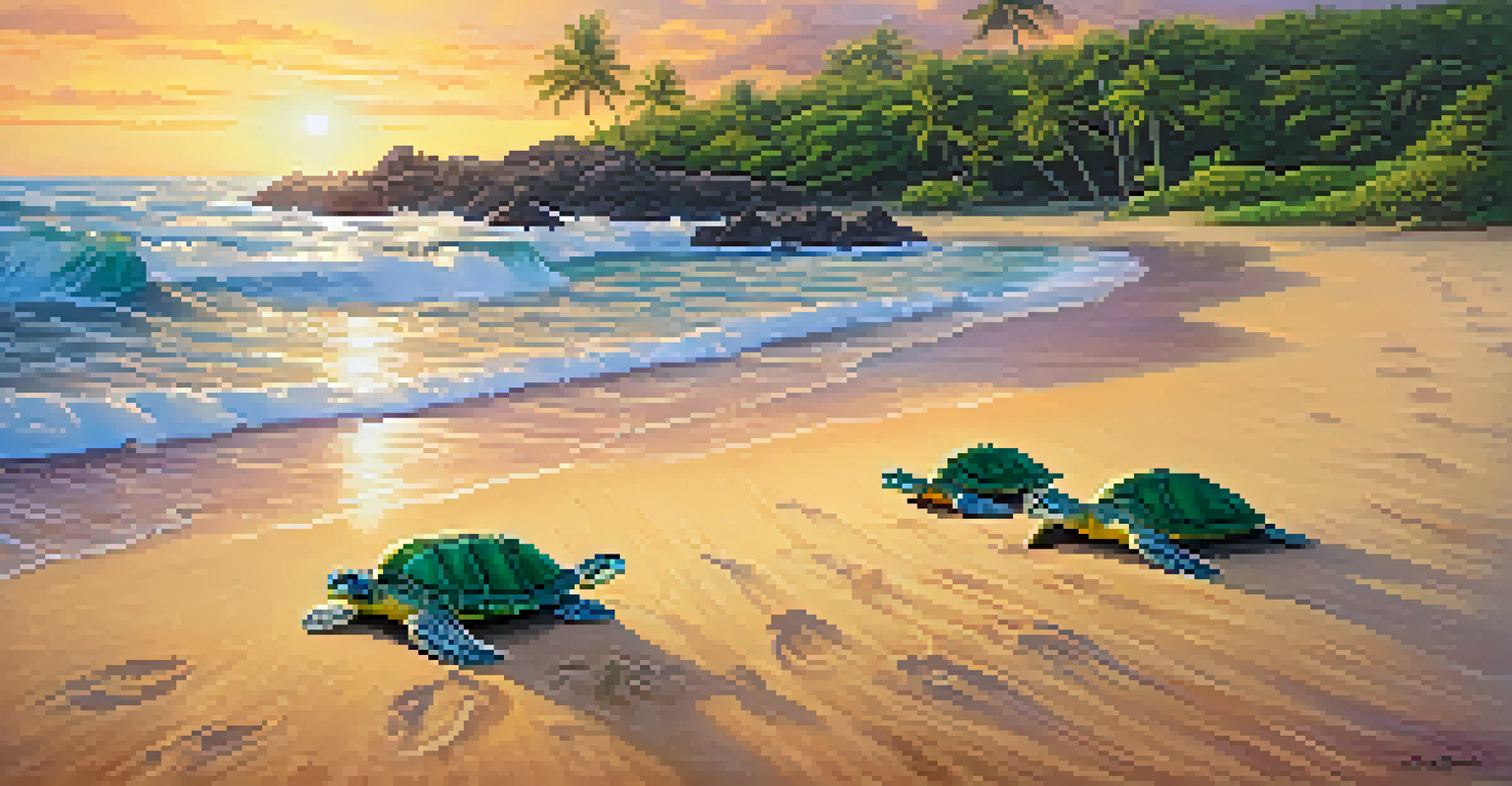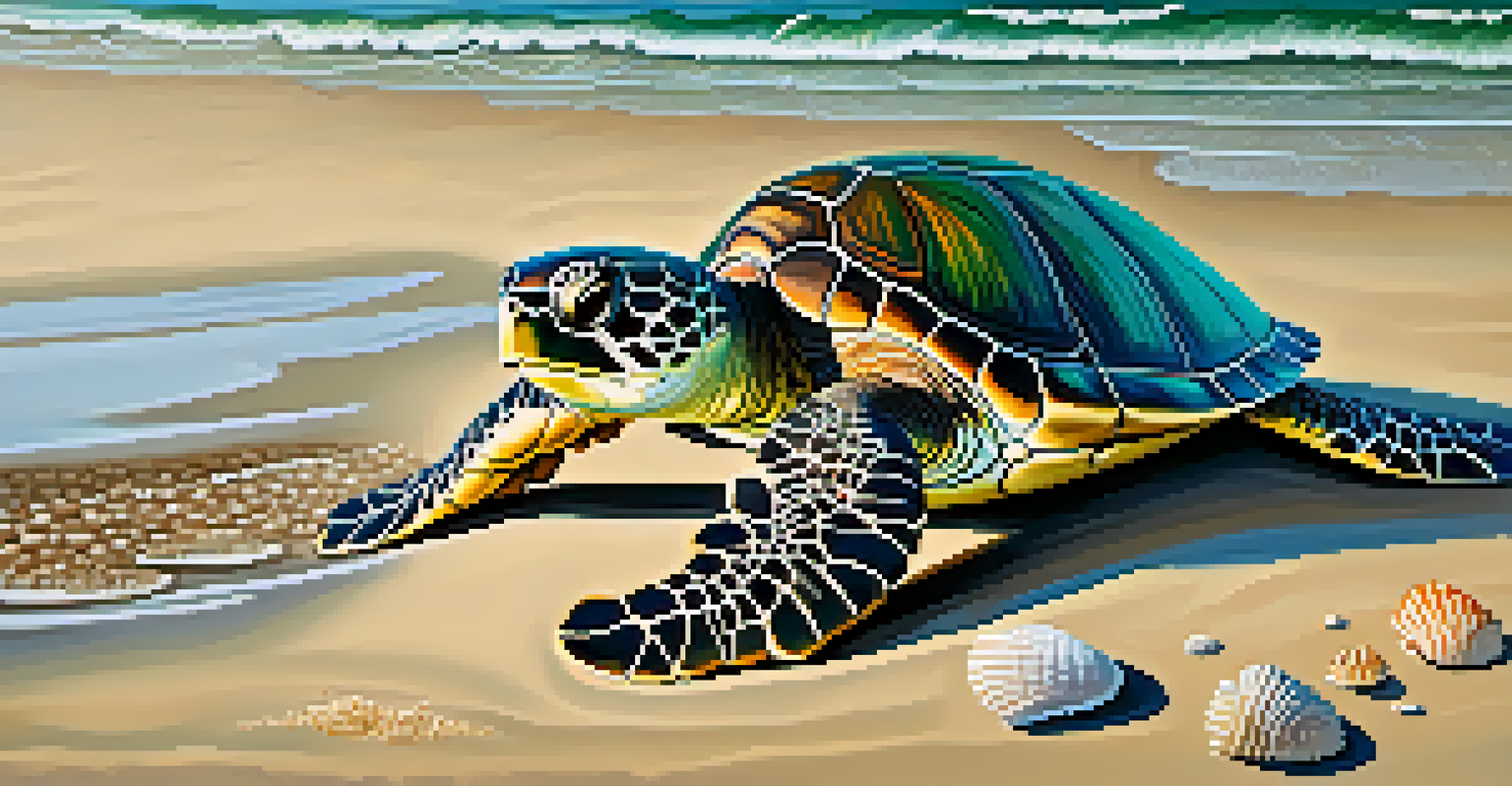Turtle Conservation: Protecting Honu in Honolulu's Waters

Understanding the Honu: Hawaii's Beloved Green Sea Turtle
The Honu, or green sea turtle, holds a special place in Hawaiian culture and ecosystems. These majestic creatures are not just beautiful to look at; they play a crucial role in maintaining the health of coral reefs and seagrass beds. As herbivores, they help control algae growth, allowing other marine life to thrive. Unfortunately, the Honu faces numerous threats that put their survival at risk.
The greatness of a nation and its moral progress can be judged by the way its animals are treated.
In Hawaiian mythology, the Honu symbolizes good luck and longevity, further emphasizing their cultural significance. Their presence in the waters around Honolulu not only enhances the marine landscape but also attracts tourists and supports local economies. However, understanding their importance goes beyond admiration; it's about recognizing our responsibility in protecting them.
With the combination of environmental challenges and human interference, the Honu population has experienced drastic declines. Therefore, conservation efforts are essential to ensure that future generations can also appreciate these magnificent turtles. By learning about the Honu, we can better advocate for their protection and promote sustainable practices in our everyday lives.
Threats Facing Honu: Natural and Human Impact
Honu face a myriad of threats, both natural and human-induced. Natural predators, such as sharks, can pose risks to juvenile turtles, but it is human activities that significantly amplify these dangers. Coastal development, pollution, and climate change have created hostile environments for these turtles, jeopardizing their habitats and food sources.

Plastic waste in the oceans is one of the most alarming dangers for Honu. Turtles often mistake plastic bags for jellyfish, leading to ingestion that can cause severe health issues or even death. Additionally, boat strikes are a common threat, as these turtles often swim near the surface, making them vulnerable to collisions with fast-moving vessels.
Honu's Ecological Importance
The Honu plays a vital role in maintaining healthy coral reefs and seagrass beds by controlling algae growth.
Climate change also plays a critical role in the survival of Honu. As ocean temperatures rise and sea levels increase, nesting sites and food availability are disrupted. These challenges highlight the urgent need for collective action to mitigate human impact and protect the delicate ecosystems that support Honu and other marine species.
Conservation Efforts: Protecting the Honu
Conservation efforts for the Honu are multifaceted, involving local communities, government agencies, and non-profit organizations. One of the primary initiatives is the protection of nesting sites, which are crucial for the reproduction of these turtles. By monitoring nesting beaches and restricting access during nesting seasons, conservationists help ensure that female turtles can lay their eggs safely.
We won’t have a society if we destroy the environment.
Education and outreach programs have also become vital in raising awareness about the importance of Honu conservation. Local schools, community groups, and tourists are encouraged to participate in workshops, beach clean-ups, and advocacy campaigns. These initiatives foster a sense of stewardship among residents and visitors alike, emphasizing that everyone can contribute to protecting these remarkable creatures.
Moreover, research plays a crucial role in conservation efforts. By studying Honu behavior, migration patterns, and population dynamics, scientists can develop more effective strategies for their protection. Collaborative efforts between researchers and conservation organizations help to ensure that the best practices are implemented to safeguard the future of Honu in Honolulu's waters.
Community Involvement: Everyone's Role in Conservation
Community involvement is essential in the fight for Honu conservation. Local residents and visitors alike can play a part by participating in beach clean-ups, reporting sightings, and following guidelines when encountering these turtles. Simple actions, like disposing of trash properly and using eco-friendly products, can significantly reduce pollution in their habitats.
Schools and community organizations often host educational events and workshops that focus on marine conservation, helping to instill a sense of responsibility in future generations. By understanding the challenges that Honu face, community members become advocates for their protection, spreading awareness and inspiring others to take action.
Threats to Honu's Survival
Natural predators and human activities, such as pollution and climate change, pose significant threats to the Honu population.
Joining forces with local conservation groups can amplify individual efforts. Many organizations offer volunteer opportunities, allowing community members to contribute directly to conservation initiatives. Whether it’s tagging turtles for research or helping with habitat restoration, being part of a team dedicated to preserving the Honu can be incredibly rewarding.
Responsible Tourism: Supporting Honu Conservation
Tourism plays a significant role in Hawaii's economy, but it can also impact local wildlife, including Honu. Responsible tourism practices can help ensure that these turtles are protected while still allowing visitors to enjoy their natural beauty. Tourists are encouraged to observe Honu from a respectful distance, avoiding any actions that might disturb them.
Many tour operators are now implementing eco-friendly practices, such as limiting group sizes during snorkeling excursions and providing educational information about Honu and their habitats. By choosing responsible tour companies that prioritize conservation, visitors can contribute positively to the local ecosystem while enjoying their experience.
Additionally, supporting local businesses that focus on sustainability can further bolster conservation efforts. Purchasing products made from eco-friendly materials or participating in local conservation programs can help create a positive impact on the environment. By making informed choices, tourists can actively support Honu conservation in Honolulu's waters.
Legislation and Policy: Protecting Honu for the Future
Legislation plays a crucial role in ensuring the protection of Honu and their habitats. Various laws and regulations, such as the Endangered Species Act and the Marine Mammal Protection Act, provide legal frameworks to safeguard these turtles from harm. These policies make it illegal to harm, harass, or kill Honu, emphasizing the importance of their preservation.
In recent years, Hawaii has enacted additional measures aimed at protecting marine wildlife, including stricter guidelines for boating and fishing practices. This legislation is designed to reduce human impact on Honu populations and their habitats, showcasing a commitment to environmental stewardship at the state level.
Community Action for Conservation
Community involvement and responsible tourism practices are essential for supporting Honu conservation efforts in Hawaii.
However, laws alone are not enough; they must be enforced and supported by community engagement. Advocacy groups and local organizations work tirelessly to promote awareness and compliance with these regulations. By supporting these efforts, individuals can play a part in fostering a culture of conservation and ensuring that Honu continue to thrive in Hawaii's waters.
The Future of Honu: Hope Through Conservation
The future of Honu hinges on our collective efforts in conservation and education. By prioritizing the protection of these turtles and their habitats, we can foster healthier marine ecosystems that benefit not only Honu but countless other species. Each small action contributes to a larger movement towards sustainability that can have lasting impacts.
Ongoing research and conservation initiatives continue to provide hope for the Honu population. As more individuals, communities, and organizations become involved, the momentum for change grows. The more we learn about these turtles, the better equipped we are to implement effective strategies for their protection.

Ultimately, the story of the Honu is one of resilience and interconnection. By recognizing our role in their survival and committing to responsible practices, we can ensure that future generations will witness the beauty of these turtles swimming gracefully in the waters of Honolulu. Together, we can create a brighter future for Honu and the vibrant ecosystems they inhabit.